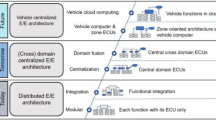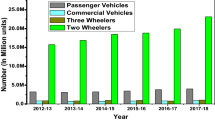Abstract
Normally, the design process of Cyber-Physical Systems (CPSs) starts with the creation of functional models that are used for simulation purposes. However, most of the time such models are not directly reused for the design of the architecture of the target CPS. As a consequence, more efforts than strictly necessary are spent during the CPS architecture design phase. This paper presents an approach called Assisted Transformation of Models (AST), which aims at transforming functional (simulation) models designed in the Simulink environment into architectural models represented in the Architecture Analysis and Design Language. Using AST, designers can perform a smooth transition between these two design phases, with an additional advantage of assuring the coupling between functional and architectural models. The use and benefits of AST are exemplified in the paper in a study devoted to for the design of a typical CPS: an Unmanned Aerial Vehicle.















Similar content being viewed by others
References
(AVSI), A.V.S.I. (2010) The system architecture virtual integration program. http://savi.avsi.aero
Chkouri M, Bozga M (2009) Prototyping of distributed embedded systems using AADL. In: Baelen SV, Weigert T, Ober I, Espinoza H (eds) 2nd international workshop on model based architecting and construction of embedded systems (ACES-MB 2009), CEUR workshop proceedings, vol 507, pp 65–79
Correa T, Becker LB, Farines JM, Bodeveix JP, Filali M, Vernadat F (2010) A model-based design methodology for cyber-physical systems. In: 6th embedded real time software and systems conference (\(\text{ ETRS }^2\) 2010)
Delange J, Pautet L, Hugues J, De Niz D (2010) An MDE-based process for the design, implementation and validation of safety-critical systems. In: 15th IEEE international conference on engineering of complex computer systems (ICECCS 2010), pp 319–324. doi:10.1109/ICECCS.2010.12
Donadel R, Raffo G, Becker L (2014) Modeling and control of a tiltrotor UAV for path tracking. In: 19th IFAC World Congress, pp 3839–3844. IFAC. doi:10.3182/20140824-6-ZA-1003.01735
Feiler PH, Gluch DP (2012) Model-based engineering with AADL: an introduction to the SAE architecture analysis & design language. Addison-Wesley, New York
Gonçalves F, Bodanese J, Donadel R, Raffo G, Normey-Rico J, Becker L (2013) Small scale UAV with birotor configuration. In: IEEE international conference on unmanned aircraft systems (ICUAS 2013), pp 761–768
Gonçalves F, Donadel R, Raffo G, Becker L (2013) Assessing the use of Simulink on the development process of an unmanned aerial vehicle. In: 3rd workshop on cyber-physical systems (CyPhy 2013)
INRIA ESPRESSO Team (2010) Polychrony. http://raweb.inria.fr/rapportsactivite/RA2010/espresso/uid27.html
Lasnier G, Pautet L, Hugues J, Wrage L (2011) An implementation of the Behavior Annex in the AADL-toolset Osate2. In: Perseil I, Breitman K, Sterritt R (eds) 16th IEEE international conference on engineering of complex computer systems (ICECCS 2011). IEEE Computer Society, pp 332–337. doi:10.1109/ICECCS.2011.39
Lasnier G, Zalila B, Pautet L, Hugues J (2009) Ocarina: an environment for AADL models analysis and automatic code generation for high integrity applications. In: 14th Ada-Europe international conference on reliable software technologies (Ada-Europe 2009). Springer, New York, pp 237–250. doi:10.1007/978-3-642-01924-1_17
Le Guernic P, Gautier T, Le Borgne M, Le Maire C (1991) Programming real-time applications with SIGNAL. Proc IEEE 79(9):1321–1336
Lee E (2008) Cyber physical systems: design challenges. In: 11th IEEE international symposium on object oriented real-time distributed computing (ISORC 2008), IEEE Computer Society, pp 363–369. doi:10.1109/ISORC.2008.25
Mathworks T (2011) Using Simulink. http://www.mathworks.com/access/helpdesk/help/pdf_doc/simulink/sl_using
Miller J, Mukerji J (2000) MDA Guide Version 1.0.1. Technical Report, Document omg/2003-06-01, Object Management Group
Raghav G, Gopalswamy S, Radhakrishnan K, Delange J, Hugues J (2009) Architecture driven generation of distributed embedded software from functional models. In: Ground vehicle systems engineering and technology symposium (GVSETS 2009)
SAE (2006) SAE AADL meta model and XML/XMI. http://www.aadl.info/aadl/currentsite/tool/metamod.html
SAE (2011) SAE Architecture Analysis and Design Language (AADL); Annex vol 2: Annex B: Data Modeling Annex, Annex D: Behavior Model Annex, and Annex F: ARINC653 Annex. http://standards.sae.org/as5506/2
Selic B, Gérard S (2014) Modeling and analysis of real-time and embedded systems with UML and MARTE. Morgan Kaufmann, Burlington
The CESAR Project (2010) Cost-eficient methods and processes for safety relevant embedded systems. http://www.cesarproject.eu
Yu H, Ma Y, Glouche Y, Talpin JP, Besnard L, Gautier T, Guernic PL, Toom A, Laurent O (2011) System-level co-simulation of integrated avionics using Polychrony. In: 2011 ACM Symposium on applied computing (SAC 2011). ACM, New York, pp. 354–359. doi:10.1145/1982185.1982263
Zowghi D, Coulin C (2005) Requirements elicitation: a survey of techniques, approaches, and tools. In: Aurum A, Wohlin C (eds) Engineering and managing software requirements. Springer, Berlin, pp. 19–46. doi:10.1007/3-540-28244-0_2
Acknowledgments
Authors would like to thank the Brazilian funding agency CAPES for their support for the development of this work.
Author information
Authors and Affiliations
Corresponding author
Rights and permissions
About this article
Cite this article
Passarini, R.F., Farines, JM., Fernandes, J.M. et al. Cyber-physical systems design: transition from functional to architectural models. Des Autom Embed Syst 19, 345–366 (2015). https://doi.org/10.1007/s10617-015-9164-y
Received:
Accepted:
Published:
Issue Date:
DOI: https://doi.org/10.1007/s10617-015-9164-y




